Review Article
Analysis of Motivational Factors, Deterrents, and Blood Donor Knowledge in Zimbabwe
4638
Views & Citations3638
Likes & Shares
Background: Blood is a body fluid responsible for transportation of nutrients, oxygen and metabolic waste. It is a non-pharmaceutical product obtained through voluntary donations. Blood transfusion is very important in the health system of any nation. Patients who are in need of blood donation expect the availability of adequate blood to satisfy their demands. Nevertheless, this is not so, mainly in third world countries like Zimbabwe where less than 6 people donate blood per 1000 populace. We need to deeply understand motivators, possible deterrents and available blood donor knowledge in order to have adequate regular voluntary non-remunerated blood donors.
Methods: A cross sectional study of donors incorporating purposive sampling technique was used and a sample size of 465 was used. A self-administered questionnaire was used where donors were rating importance of factors that motivate or deter their interest to donate blood and rate their blood donation knowledge. Statistical methods were used for reliability and correlation tests.
Results: Most of the 465 participants were 1st time donors 262 (56.3%) and 203 (43.7%) had some donation history. All donors endorsed that there exist factors that motivate them to donate blood which included the desire to help someone in need 386 (83%), good attitude of staff 419 (90%), reminders to donate 381(82%) and donor incentives 409 (88%) with their corresponding response rate. Six out of the nine suggested deterrents were endorsed as significant deterrents to blood donation. The corresponding support rate for each deterrent are absence of incentives 529(82%), poor attitude of staff 363(78%), myths and beliefs, 330(71%), feeling bad after donation, 251(54%) and the belief that blood will be sold 330(71%). Most people did not know the minimum age to donate blood as only 54 (11.61%) and only 168(36.13%) knew the correct interval between donations which should be 4 months. Only 171(36.77%) knew that blood expire.
Conclusion: Our findings suggest that more donor drives need to be taken educating people on blood donation, motivating donors to donate whenever there is blood shortage. Young donors are more attracted to concrete items as incentives and females donate more than males. Attitude of staff can motivate or demotivate donors to continue with this altruism gesture.
Keywords: Blood, Blood donation, Motivators, Deterrents, Principal component analysis
ABBREVIATIONS
WHO: World Health Organization; NBSZ: National Blood Service Zimbabwe; TTIs: Transfusion Transmissible Infections; HIV: Human Immune Virus
INTRODUCTION AND BACKGROUND
Blood is a specialized body fluid found in humans and other animals. It is a combination of plasma, red blood cells, white blood cells, and platelets. Blood has different functions that include transporting oxygen and nutrients, carrying cells and antibodies that fight infection, transporting metabolic waste products, and temperature regulation. Blood transfusion is an indispensable component of healthcare worldwide. It permits complex medical and surgical interventions and improves life expectancy and patient outcomes with a variety of acute and chronic diseases. Blood donation is a symbol of giving life, this act is crucial in every healthcare system [1]. On blood donation voluntary healthy individuals give blood free of charge so that it will be used by some other individual in transfusion therapy. It is a patient’s right when in need of blood transfusion service as part of their therapy to have adequate blood supply. However, in the third world countries there are rampant discrepancies between blood demand and supply leading to unnecessary suffering or even death of many patients [2, 3]. Tapko [4] reported that blood inadequacy in the developing world mainly affect children with anemia, malaria and expecting mothers who have complications related to pregnancy. At most 34% of maternal deaths in Africa are caused by bleeding in the labor process which could be avoided if adequate supplies of blood are available [5].
Additionally, man-made disasters like accidents, and conflicts further increase the burden for blood demand in Africa. Many developing countries in their blood banks have much less blood than the blood needed, hence access to blood is a right but remains a challenge. Around 108 million units of blood are collected per annum globally, with more than 50% from the developed world with 20% of the overall world populace [1]. Annually around 234 million major clinical operations are performed globally where blood transfusion is mandatory [6]. World Health Organization (WHO) recommends that every ten humans per thousand populaces in any given nation need to be regular voluntary blood donors for that nation to have sufficient stocks of blood all the time [4]. However, Zimbabwe has not managed to surpass six voluntary and non-remunerated blood donors per one thousand populaces. This has provided extreme blood and blood products shortages within the country with some cases resulting in undesirable fatalities [7]. The World Health Organization recommends that all nations should be self-sufficient in all blood products and that all blood donations should be voluntary, anonymous and non- remunerated. However, blood supplies for over 62 countries in the world are now 100% dependent on voluntary, anonymous and non-remunerated blood donations [8, 9]. To achieve this good objective blood banks authorities and volunteers have to work together, and a big investment for recruiting and preserving regular voluntary blood donors has to be secured [10]. All blood donors should be tested for transfusion transmissible infections (TTIs) like HIV, syphilis, hepatitis B and C among others [4].
With an ever-growing demand on blood supplies internationally, there's a tremendous desire to ensure a secure and sufficient supply of blood products. However, recruiting and maintaining blood donors stays a key undertaking for blood organizations internationally. We need a deep understanding of factors that affect blood donation. We also need to adequately have enough information and knowledge of blood donors as donors are inspired to donate if they have full information about the process and benefits of being a donor. There are African myths and fears associated with blood donation which needs to be demystified.
Blood donation has been studied in the literature as one of the most essential gestures of “natural altruism” since one donates blood not know the person that will receive it [11]. Multiple elements with effects on the behavior of volunteers have been studied and volunteer motivation was found to be the most significant push for blood donors [12]. Most blood donors in Zimbabwe are the high school going age accounting for on average 70% of total collections and the remainder being donated mainly by the pledge 25 club members and other adults [13]. Regardless of the abundance of this age group in Zimbabwe’s donor pool, the nation experience blood shortages and very little information is known about the motivational factors have an effect on their donation behavior. National blood service Zimbabwe is comprised of 5 branches distributed within the country’s major provinces. For the past five years total national collections dropped from approximately 82 000 units per year in 2012 to below 62000 units in 2016 [7, 13-16].
Misje and Heier [17] used stepwise regression to determine which variables predicted the blood donation motivation significantly and factors with factor loadings greater than 0.4 were considered significant. Altruistic motivational factor is relatively high amongst women, leading to a greater response to altruistic messages by women, hence more efforts must be made to attract female donors [18, 19]. Asamoah-Akuok [20] found that in many African populations, fear and beliefs are the major barriers to blood donation as most African residents lack knowledge about blood donation. However, in Zimbabwe there is little published literature on motives and barricades that respectively drive and deter blood donations. It is against this background that we want to analyze factors that motivate or deter blood donors and also increase knowledge about blood donation in order to increase recruitment and retention of voluntary non-remunerated donors.
RESEARCH METHODOLOGY
The purpose of this study was to perform a deep analysis of blood donor motivators, possible deterrents and increase blood donor knowledge on the benefits of donating blood so as to increase recruitment and retention of voluntary non-remunerated donors, thereby appeasing blood shortages within the country.
Research design, target population and sample size
The study was carried out in Manicaland province using a cross sectional approach. The variables of interest in this study were, motivational factors, potential deterrents, demographics and knowledge on blood donation. All blood donors above 17 years of age who donated blood in 2018 and were willing to participate in the study in Manicaland province constituted our target population, irrespective of gender. All new and repeat donors were considered excluding those who did not consent. Purposive sampling technique was used, and sample size was estimated using the Fischer’s method of estimating sample size at 5% level of significance was used. On the prevalence rate we used 50% due to the lack of published information on motivators and deterrents in Zimbabwe [21].
where, is the minimum sample size required, is the absolute precision is the standard normal deviate at 95% confidence interval (1.96) and is the assumed proportion of the population that has knowledge on blood donation ( ) Using equation, (1), the sample size plus is: . Then using the general rule of 18% allowance for spoilt or incomplete questionnaires gives us a total sample size of 455.
Data collection
The blood drives were conducted at different dates within the province. All donors were informed on the objectives, possible benefits of the study and their role, and encouraged to participate voluntarily. All participants who voluntarily took part in the study endorsed their consent by signing a consent form. Confidentiality and anonymity of the study participants were maintained at all levels of the study. Self-administered questionnaire was used to collect data and it was designed to include significant variables from other studies which includes among others Chacón [12], Asamoah-Akuok [20] and Mohammed and Barton [22]. The variables of interest were grouped as personal characteristics of participants, motivators, barricades and knowledge about blood donation. Information from the National Blood Services Zimbabwe (NBSZ) was used to construct questions on knowledge about blood donation.
Data analysis
Data was checked for any missing attributes then Microsoft Excel and Stata v14 were used in analysis. All questionnaires with missing information were rejected. Measures of central tendency and dispersion were used to test for skewness and kurtosis. Response frequencies between variables were computed and presented in table formats, we considered donor status (1st time or non-1st time) as the response variable and its association with the explanatory variables were determined at 5% level of significance.
A data reduction method called factor analysis was used to fully uncover the latent structure of factors affecting blood donation in Zimbabwe. Principal axis factoring solution was used to significant factors and the Eigen value criterion and scree plot on an unrotated factor matrix were used to decide on factors to retain (factors with Eigen value >1 was retained). The factor matrix was then rotated to obtain a factor pattern and only correlations or factor loadings >±0.40 were considered. Factor loadings are correlation coefficients between observed variables and latent common factors which can also be viewed as standardized regression coefficients. Factor loadings close to -1 or 1 shows that the factor strongly influences the variable and those close to 0 indicate that the factor has a weak influence on the variable.
Cronbach's alpha test is a coefficient of reliability or a measure of internal consistency was used to test the factor’s reliability and those factors with greater probability values are more reliable. Stepwise ordinal logistic regression was done on responses to explanatory variables and the combined influence on personal characteristics (age, gender, marital status, highest education level, and donor status) was evaluated on each of the ordinal outcomes. Significant factors had P values less than 0.05.
RESULTS
Data presentation
Seventeen blood drives were conducted at different centers in the province. 485 questionnaires were distributed and 5 went missing with 15 being disqualified due to incompleteness. A total of 465 completed questionnaires were then analyzed. A summary of the personal characteristics is summarized in Table 1. From 465 accepted respondents 262 (56.3%) were first time donors and 203 (43.7%) were non-first-time donors who participated in the survey. Most of the blood donors were of the school and college going age (16-24) accounting for 30.5% of our study population while only 48 (10.3%) were above 40 years of age. Male donors were outnumbered by females’ donors with 287 (61.7%) females and 178 (38.3%) males.
From Table 1, we observed that females are more likely to donate blood than males as there were also more 1st time female donors than males. The NBSZ mainly depends on the school going ages for blood donations as most donors lie in this category students accounting of 61.94% for the sampled population. The donor drives being conducted in the province yielded an increase in the donor pool by 262 (56.3%) 1st time donors.
Factor analysis
Factor analysis was conducted to uncover the latent structure of motives. Factors were extracted using the common factor (principal axis factoring) method (Table 2).
Twenty of the motivation related items in the questionnaire were adapted directly from the VFI in Vincent [21]. The statements B, F, J, M and N correspond to the value factor; A, C, E, K and O correspond to the social factor; G, I, L, P, T correspond to the understanding factor; D, H, Q, R and S correspond to the enhancement factor. Oblique rotation method permits factors to be correlated with each other thus representing clustering of variables more accurately. This was used to rotate the factor loading matrix and loadings greater than 0.4 were considered important. Cronbach’s alpha test was considered for testing factor reliability with values ranging between 0 and 1, higher alpha values indicate higher reliability. All the three factors had higher reliabilities shown by the Cronbach’s alphas of 0.7685, 0.7850 and 0.7750 as shown in Table 2 for factor 1, 2, 3 respectively. The overall system reliability was 0.8753 which indicates a strong measure of internal consistence. The Kaiser-Meyer-Olkin (KMO) is a statistic between 0 and 1 used to measure data suitability for factor analysis, or sampling adequacy. Higher KMO values indicates better sampling adequacy. An overall KMO score of 0.8406 was obtained, hence the sample size was adequate enough to proceed with factor analysis.
A scree plot of the Eigen values was computed to confirm whether there was a break in the plot with the remaining factors explaining considerably less variation. From the scree plot only three factors were significant. These three factors met the Kaiser’s rule (Eigen value >1 criterion), with the first factor having the largest Eigen value of 5.3. The first factor which is correlated to the variables S, P, T, Z, V, G and Y is the understanding factor of the VFI. Factor 1 explained the largest proportion of the total variation (57.3%). The second factor with variables M, Q, R, B, D, N, H and I. Variables M, B and N correspond to the Value factor of the VFI. Variables Q, R, D and H correspond to the Enhancement factor of the VFI. Variable I correspond to the Understanding factor. The results revealed that eight items had factor loadings greater than 0.4. This second factor accounted for 22.3% of the total variation and was labelled as a merged factor, Value and Enhancement factor. The last factor was formed by the correlation between variables A, C, K and E which all corresponds to the Social factor of the VFI, with the highest loading of 0.7240 and the lowest loading 0.5720. The factor was labelled the Social factor representing blood donation as way to develop and strengthen social ties. Factor 3 explained 12.7% of the total variation in the data (Figure 1).
Motivating factors
A summary of responses to different motivators for blood donation is given in Table 3. For a sample size of 465 at most 83% (386) of blood donors agreed that they donate blood when there is someone in need of blood. 90% of donors are motivated by good attitude of NBSZ staff compared to only 7% (33) that do not mind the attitude of clinic staff. Issue of incentives is also a critical motivator as 88% (409) of the participants agreed to this as a motivator and only 2% was undecided as far as compensation for donating blood is concerned. Many donors concurred that road shows and reminders to donate blood are important to replenish national blood banks. Most 1st time donors join the blood donor family because of different motivators with some shown in Table 2 and non-1st time donors mostly need reminders whenever there is shortage of blood.
Possible blood donor deterrents
Deterrents to blood donation were evaluated and summarized in Table 4. Six out of the nine suggested deterrents were endorsed to be significant to blood donation. Absence of incentives among the donors was cited as the major barrier by most donors as approximately 529 (82%) endorsed this barrier while only 65 (14%) did not agree. The other endorsed factors are poor attitude of staff, 363(78%), myths and beliefs, 330 (71%), some said donating blood takes much of their time, 284 (61%), feeling bad after donation, 251 (54%) and the belief that blood will be sold for the organization to make profit, 330 (71%). Hating the sight of blood, distance of NBSZ from the donors, and that donating blood is inconvenient were not endorsed as significant barriers to blood donation with 16%, 20%, 43% as the response rates in support of these factors respectively. Most of the fears were among the 1st time donors as they were the majority in this study.
Blood donor basic knowledge
Table 5 gives a summary of donors’ knowledge about blood donation. Most people did not know the minimum age to donate blood as only 54 (11.61%) out of a total of 465 knew this. Some donors (39.57%) were not sure of the interval between donations and 168 (36.13) knew the correct interval which should be 4 months. Most of the participants (43%) had no idea on expiry of blood as only 171 (36.77%) knew that blood expire. On the last variable considered many participants, 410 (88.17) knew that an HIV patient cannot donate blood.
Test for Associations
A chi squared test was used for association between age and the number of donations. There was a significant association between number of donations and age of the blood donors (p value = 0.000)
The following hypothesis was tested at 5% level of significance.
H0: Blood donation behavior is mostly driven by the value factor.
H1: Blood donation behavior is not driven by value factor.
Factor analysis indicated that the understanding factor had the highest Eigen value (5.2) hence explaining a greater proportion of the total variation (57.3%). So, we fail to reject the null hypothesis and conclude that the blood donation behavior in Zimbabwe is mostly driven by the understating factor (factor 1).
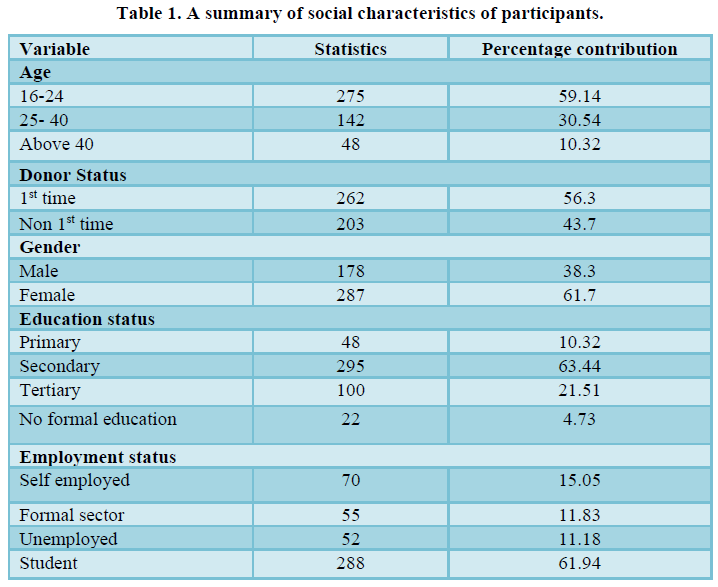
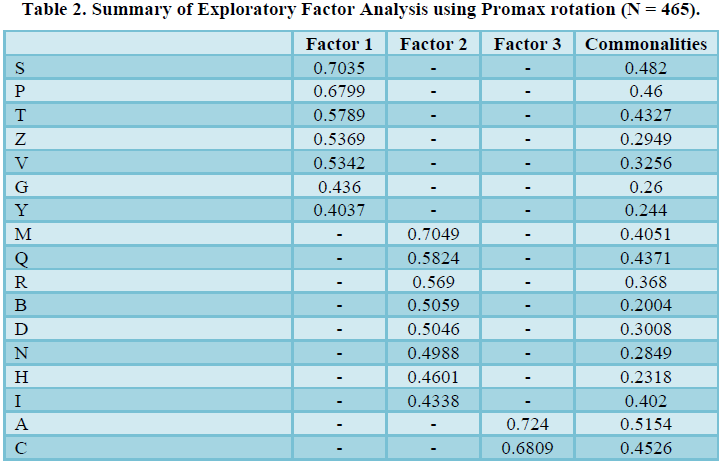

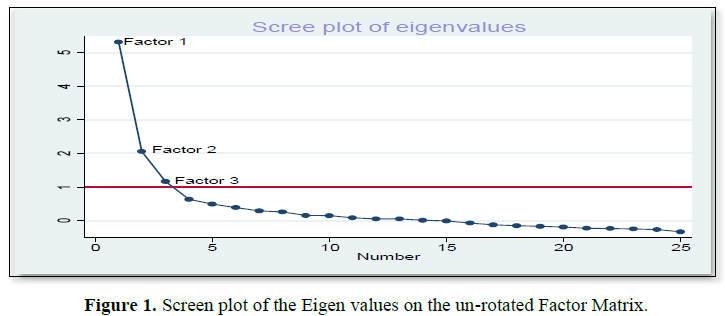
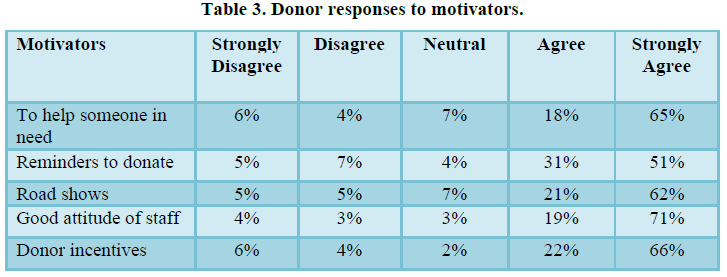
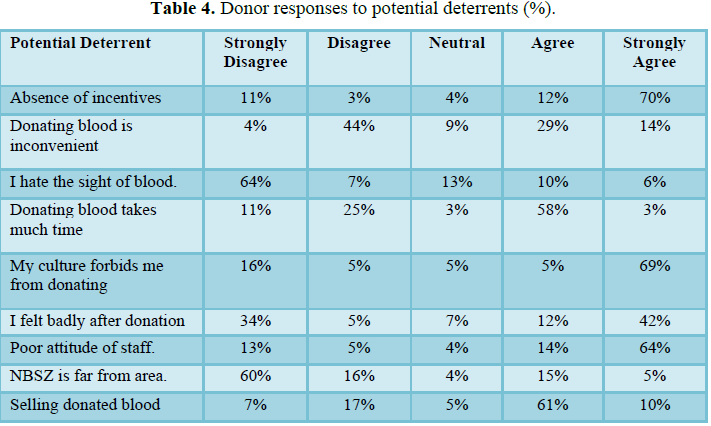
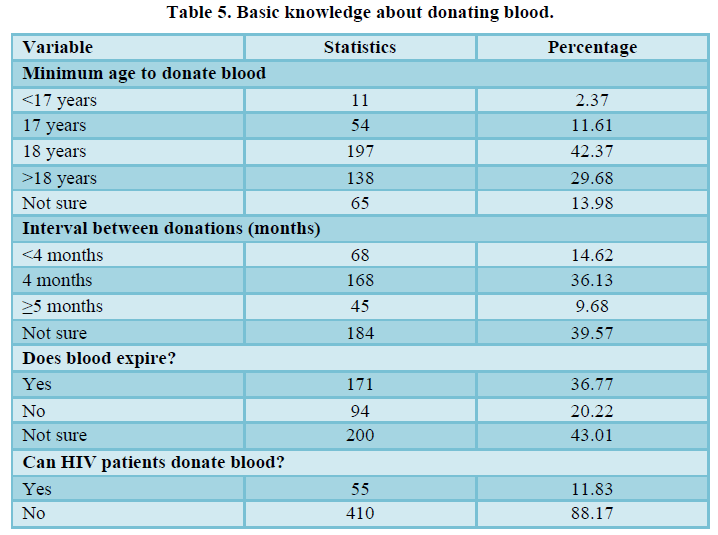







DISCUSSION
Maintaining a sustainable and adequate supply of blood and blood products is the main thrust of any blood service organization across the globe. To meet the blood demand, it is important to deeply understand factors that motivate and those that deter blood donors from effectively participating in these voluntary programs so that effective recruitment programmes will be formulated. This study was dominated by 1st time donors, which contradicts findings reported in other studies [23-25]. The variation in findings may be due to the geographical locations of the study areas. Some were done in developed world, but these findings agreed to Mohammed and Barton [22] who did their study in Ghana. With the majority of donors being 1st time donors developing nations are more likely to encounter challenges in as much as ensuring adequate supply of blood is considered. The findings in this study also revealed that females donated more than males which also contradicts findings in Vincent [21] and Finck [26] for high school going age groups. There is need for retention of 1st time donors to be regular donors as altruism (philanthropy) is among the common motivators that are associated with the repeat donors. Philanthropic donors constituted 83% of study participants and are very much influenced by the desire to help others in need of blood. 80% of the participants are motivated by peers and other people they know; hence most people donate blood due to social influence. However, it is important to note that there is a belief that blood contains characteristics of the donor hence some blood recipients prefer blood from a relative or family member whom they know their characteristics. Mohammed and Barton [22] reported that people donating blood to a relative was more acceptable in Cameroon as compared to donating to blood institutions to be given to strangers. Good attitude of staff, reminder for donations through road shows, radio and tv presentations by famous blood recipients, incentives for donations were endorsed as strong motivators for blood donation. Almost similar findings were reported in Ghana by Mohammed and Barton [22] and by Maghsudlu [27] in Iran. Non 1st time donors are more encouraged by the friendly attitude of staff. When donors feel motivated and appreciated, they are more likely to return for repeat donations. As most of the donors are of school going age, they cited donor incentives which includes branded stationary, wears, cash and other gifts as a significant motivator for blood donation.
This study found that six out of the nine suggested deterrents were significant deterrents to blood donation. Absence of incentives, poor attitude of staff, myths and beliefs, donating blood takes much time, feeling bad after donation, and the belief that blood will be sold for the organization to make profit were the most endorsed deterrents to blood donation. However, Asamoah [20] and colleagues concurred with our findings that fears related to pain, and after donation effects are important deterrents in blood donation. The geographical location of donation centers was identified as a non-deterrent factor which contradicts the findings of Yuan [28] who reported that location of the donation centers is among common deterrents among college students in California. We found that at least 80% of the donors do not have idea of the minimum age for blood donation, only 36% know the recommended interval between two donations but most people know that HIV positive patients are not eligible to donate blood. These findings are consistent with the findings of Melku [29] in Ethiopia and Mohammed and Barton [22] who did their research in Ghana. The research findings mean that there is need for more educational campaigns on blood donation. These can be done in all areas of public gathering, communities, on all social media platforms including radio and televisions.
CONCLUSION
In a nutshell, the findings of the study provide empirical evidence for the utilization of the VFI in the Zimbabwean context. We found that most donors are philanthropist though they have that zeal for incentives, they desire to assist those in need of blood. Blood donation is also influenced by staff attitude and cultural beliefs. Our findings suggest that the public needs to be educated on blood donation to increase the national donor pool, and staff needs to be motivated as their attitude can motivate donors so that blood shortages will be eliminated.
- Mauka WI, Mahande MJ, Msuya SE, Philemon RN (2015) Factors associated with repeat blood donation at the Northern Zone Blood Transfusion Centre in Tanzania. J Blood Transfus 2015: 717653.
- World Health Organization and International Federation of Red Cross (2010) towards 100% Voluntary Blood Donation: A global framework for action. Geneva. Available online at: http://www.who.int/iris/handle/10665/44359.
- World Health Organization (WHO) (2013) Current status on blood safety and availability in the WHO African region.
- Tapko JB, Toure B, Sambo LG (2014) Status of Blood Safety in the WHO African Region: Report of the 2010 Survey. Brazzaville. Available online at: http://who.insomnation.com/sites/default/files/pdf/status-of-bloodsafety- in-the-who-african-region.pdf
- World Health Organization (WHO) (2014) Campaign Essentials: World Blood Donor Day 2014. Geneva. Available online at: http://www.who.int/campaigns/world-blood-donorday/2014/en/
- Societies RC (2013) IFRC annual report 2013. Available online at: https://www.ifrc.org/annual-report-2013/
- National Blood Service Zimbabwe (NBSZ) (2013) Annual Report 2013.
- World Health Organization (WHO) (2015) Campaign Essentials: World Blood Donor Day 2015. Geneva. Available online at: http://www.who.int/campaigns/world-blooddonor-day/2015/campaign-essentials/en/
- Amatya M (2013) Study on knowledge, attitude and practice of blood donation among students of different colleges of Kathmandu, Nepal. Int J Pharm Biol Arch 4(3): 424-428.
- World Health Organization (WHO) (2009) The Melbourne Declaration on 100% voluntary non-remunerated donation of blood and blood components. Geneva. Available online at: https://www.who.int/worldblooddonorday/Melbourne_Declaration_VNRBD_2009.pdf?ua=1
- Guiddi P, Alfieri S, Marta E, Saturni V (2015) New donors, loyal donors and regular donors : Which motivations sustain blood donation ? Transfus Apher Sci 52(3): 339-344.
- Chacón F, Gutiérrez G, Sauto V, Vecina ML, Pérez A (2017) Volunteer Functions Inventory: A systematic review. Psicothema 29(3): 306-316.
- National Blood Service Zimbabwe (NBSZ) (2016) Annual Report.
- National Blood Service Zimbabwe (NBSZ) (2012) Annual Report.
- National Blood Service Zimbabwe (NBSZ) (2014) Annual Report.
- National Blood Service Zimbabwe (NBSZ) (2015) Annual Report.
- Misje AH, Bosnes V, Gåsdal O, Heier HE (2005) Motivation, recruitment and retention of voluntary non- remunerated blood donors : A survey-based questionnaire study. Vox Sang 89(4): 236-244.
- Glynn NW, Kimm SYS, Kriska AM, Barton BA, Kronsberg SS, et al. (2002) Decline in physical activity in black girls and white girls during adolescence. N Engl J Med 347: 709-715.
- Steele WR, Schreiber GB, Guiltinan A, Nass C, Glynn SA, et al. (2008) The role of altruistic behavior, empathetic concern, and social responsibility motivation in blood donation behavior. Transfusion 48(1): 43-54.
- Asamoah-Akuoko L, Hassall OW, Bates I, Ullum H (2017) Blood donors’ perceptions, motivators and deterrents in sub-Saharan Africa-A scoping review of evidence. Br J Haematol 177(6): 864-877.
- Vincent K, Esther C, Maxwell M, Chandiwana E (2019) Factor Analysis of Motivational Factors among Experienced Blood Donors: A Case of High Schools in Manicaland Province Zimbabwe. J Blood Disord Transfus 10: 429.
- Mohammed S, Barton HE (2018) Motivational factors for blood donation, potential barriers, and knowledge about blood donation in first-time and repeat blood donors. BMC Hematol 18: 36.
- Wiersum-osselton JC, Der Kreek TM, Brand A, Veldhuizen I, Van Der Bom JG, et al. (2014) Risk factors for complications in donors at first and repeat whole blood donation: A cohort study with assessment of the impact on donor return. Blood Transfus 12: 28-36.
- Zanin TZ, Hersey DP, Cone DC, Agrawal P (2016) Tapping into a vital resource : Understanding the motivators and barriers to blood donation in Sub-Saharan Africa. Afr J Emerg Med 6(2): 70-79.
- Suemnig A, Konerding U, Hron G, Lubenow N, Alpen U, et al. (2017) Motivational factors for blood donation in first-time donors and repeat donors: A cross-sectional study in West Pomerania. Transfus Med 27(6): 413-420.
- Finck R, Ziman A, Hoffman M, Phan-Tang M, Yuan S (2016) Motivating Factors and Potential Deterrents to Blood Donation in High School Aged Blood Donors. J Blood Transfus 2016: 8624230.
- Maghsudlu M, Nasizadeh S (2011) Iranian blood donors’ motivations and their influencing factors. Transfus Med 21(4): 247-252.
- Yuan S, Hoffman M, Lu Q, Goldfinger D, Ziman A (2011) Motivating factors and deterrents for blood donation among donors at a university campus-based collection center. Transfusion 51: 2438-2444.
- Melku M, Terefe B, Asrie F, Enawgaw B, Melak T, et al. (2016) Knowledge, Attitude, and Practice of Adult Population towards Blood Donation in Gondar Town, Northwest Ethiopia: A Community Based Cross-Sectional Study. J Blood Transfus 2016: 1-10.
QUICK LINKS
- SUBMIT MANUSCRIPT
- RECOMMEND THE JOURNAL
-
SUBSCRIBE FOR ALERTS
RELATED JOURNALS
- Journal of Carcinogenesis and Mutagenesis Research (ISSN: 2643-0541)
- Journal of Pathology and Toxicology Research
- Journal of Neurosurgery Imaging and Techniques (ISSN:2473-1943)
- Journal of Ageing and Restorative Medicine (ISSN:2637-7403)
- BioMed Research Journal (ISSN:2578-8892)
- Archive of Obstetrics Gynecology and Reproductive Medicine (ISSN:2640-2297)
- International Journal of Diabetes (ISSN: 2644-3031)



